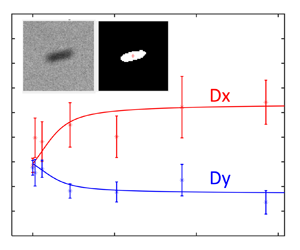Article contents
Electric-field-controlled diffusion of anisotropic particles: theory and experiment
Published online by Cambridge University Press: 17 August 2021
Abstract

We report on a theoretical and experimental study on the anisotropic diffusion of isolated prolate spheroidal particles in the presence of an aligning potential field. By analysing the microscopic stochastic equations of motion, we obtained the coarse-grained Fokker–Planck equations that govern the evolution of the probability distributions of particle orientation in various configurational spaces. In particular, we found explicit formulae for the diffusion coefficients parallel ( $D_x$) and perpendicular (
$D_x$) and perpendicular ( $D_y$) to the field direction in the long-time limit. The predicted results were experimentally validated by measuring the Brownian motions of fluid-suspended carbon nanotubes in an electric field. Good agreement was observed between theoretical and experimental results, both of which showed increasing
$D_y$) to the field direction in the long-time limit. The predicted results were experimentally validated by measuring the Brownian motions of fluid-suspended carbon nanotubes in an electric field. Good agreement was observed between theoretical and experimental results, both of which showed increasing  $D_x$ and decreasing
$D_x$ and decreasing  $D_y$ with increasing field strength up to a critical field strength beyond which both curves start to flatten. Our theory and experimental results provide a framework for understanding the coupling between rotation and translation in a diffusion process, and for controlling the diffusion of particles with aligning potential fields.
$D_y$ with increasing field strength up to a critical field strength beyond which both curves start to flatten. Our theory and experimental results provide a framework for understanding the coupling between rotation and translation in a diffusion process, and for controlling the diffusion of particles with aligning potential fields.
JFM classification
- Type
- JFM Papers
- Information
- Copyright
- © The Author(s), 2021. Published by Cambridge University Press
References
REFERENCES
- 2
- Cited by



